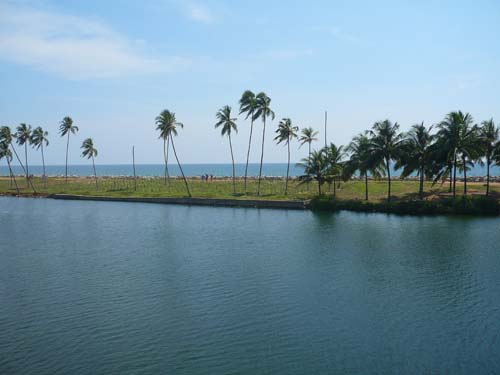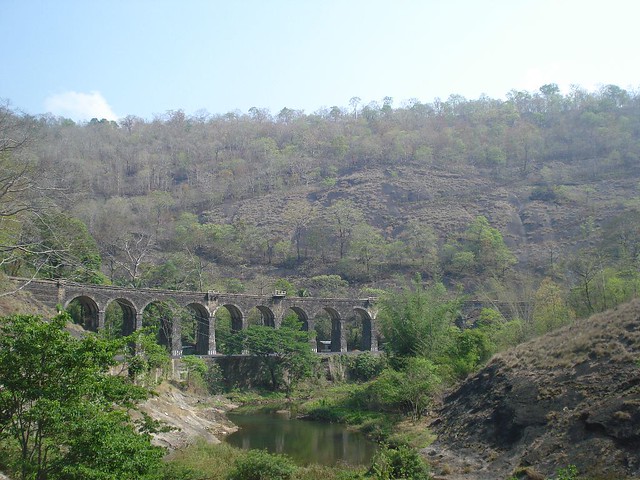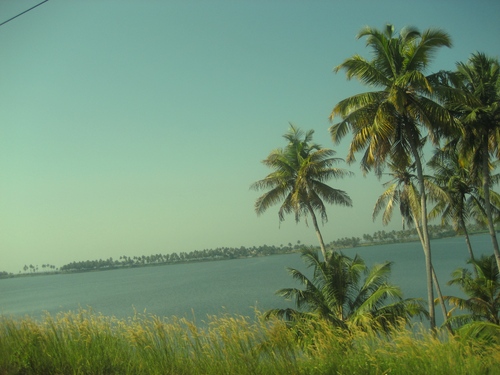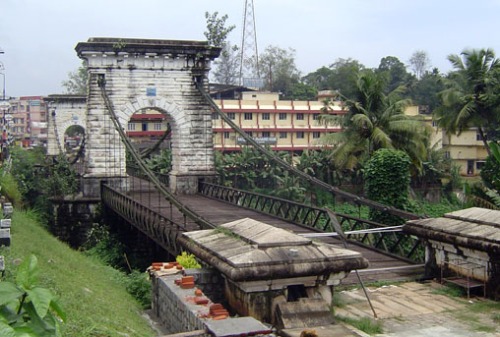KOLAM HISTORY ANDTOURIST ATTRACTIONS
History of Kollam is both old and significant. In the earlier days (8 century AD) , Kollam was called Desinganadu. In those days Kollam was the capital of a kingdom called Venad.
Roughly Venad comprised of the present day Kollam, Thiruvananthapuram and the Kanyakumari District now in Tamil Nadu. Again Venad was one of the 18 kingdoms that formed the south Indian empire called Cheran Empire. Many centuries ( read it as many battles ) later , Venad was expanded into a new kingdom called Travancore. Approximately Travencore comprised the south half of modern day Kerala from the borders ofCochin
Then came the colonial era ofIndia India Cochin 
Though its international importance faded in the past centuries, Kollam still remained as an important local trade center. It has significant production of cashew, coir, copra and tiles. Even today a tour to Kollam is never complete without a visit to the traditional tile factory and the coir making yards. The trade unionism of Kollam is as old and widespread as its factories. In the modern day Kerala, communism is as live and kicking as it was ever in the history. Kollam is no different. Its modern day politics is noisy and vibrant.The giant country barges once used to move its industrial and agricultural cargo is now converted into House boats for tourists! Though the place is no more called Venad , an express train called Venad Express connects the erstwhile Venad with Malabar. In simple terms, Venad Express connectsTrivandrum
So whatever you are seeing and experiencing in Kollam is not really disconnected from its eventful past.
Accessing Kollam (Quilon) is no great difficulty from anywhere in the country. A major rail link of the Indian Railways passes right through Quilon town. It is an important railway junction on the railway's map.So are the National Highways. National Highway 47 (NH 47) passes through Kollam. Two other national highways - NH208 and NH220 - start from Kollam. And there are numerous roads radiating out of Kollam connecting other towns and cities, both of Kerala and neighboring Tamilnadu state. The state owned KSRTC buses operate from the bus stand in the Heart of the town. All the long distance and local bus services of KSRTC operate from here. Also there are few private bus stands in the town center with frequent services to the nearby places.
Kollam has no airports.Trivandrum Cochin Trivandrum Cochin
For the curiosity's sake, Kollam do have some old airstrip, not much used for flying anymore though. The ground is now used by numerous driving schools as practice ground and of course cricket too is played on this erstwhile 'plane ground'.
Kollam is often described as the gateway to the backwaters in this part of Kerala. There is a boat jetty in Kollam with regular services to the designations in and around the district. The boat jetty is located right next to the KSRTC bus stand.
Though Kollam is a port town, there are no ferry services by sea route from Kollam. The ports are mostly used for fisheries and cargo transport.

Thirumullavaram Beach

The bridge which was constructed during the British regim using Surki construction. In this period there were no cement in use for constructions. 
This bridge holds one of India

Tags:Kollam Tourism, Tourist Places in Kollam, Tourism in Kollam, Tourist Attractions in Kollam, Tourist Destinations in Kollam, Kollam Tourist information, Kollam travel, Tours to Kollam, Kollam Kerala, Kollam attractions in Kerala, Kollam Beaches
Kollam also called Quilon is a district in south Kerala. The capital of the district is also known by the same name. Kollam is a mid sized coastal town located in the west of the district where it meets the Arabian Sea .
Geographically Kollam represents a sample slice of what Kerala is. The west of Kollam is a long wide coastline facing the Arabian Sea . The eastern edge of Kollam district is hilly, and gradually merges into the fringes of Western Ghats . The plane midland lies between the western coastal strip and the hilly eastern region. On the planes is the giant Ashtamudi Lake
History of Kollam is both old and significant. In the earlier days (8 century AD) , Kollam was called Desinganadu. In those days Kollam was the capital of a kingdom called Venad.
Roughly Venad comprised of the present day Kollam, Thiruvananthapuram and the Kanyakumari District now in Tamil Nadu. Again Venad was one of the 18 kingdoms that formed the south Indian empire called Cheran Empire. Many centuries ( read it as many battles ) later , Venad was expanded into a new kingdom called Travancore. Approximately Travencore comprised the south half of modern day Kerala from the borders of
Then came the colonial era of

Then came the Nestorian Christian merchants. They settled in Kollam. The history of Syrian Christianity of Kollam practically starts with their arrival. So is the Malayalam era calendar that is believed to be established by Nestorian Christian in 825 AD. The calendar is called Kollavarsham , literally Year of Kollam. Kollavarsham continues to be the traditional calendar of Kerala. Now, the word Kollam in Malayalam language is synonym to the word year.
The arrival of European traders in Kollam started with the Portuguese in 1502 AD, the Dutch in 1661 AD and finally the British. The European merchants were slightly different from the Chinese, Persian, Phoenician and the Roman merchants who already had long established trade base in Kollam many centuries before the arrival of European merchants.
Their trade interest gave way to power struggle. The rivalries between the local kings were exploited to the core to by the competing European traders to establish foothold. A place called Thangasseri in the northern fringe of Kollam town still has the remains of the Dutch fort. The British were more successful than the Portuguese and the Dutch. The British influence on the local rulers lasted till the end of colonial era in 1947.
Velu Thampi, the Dalava ( prime minister) of Travancore made famous proclamation in 1809 in urging people to fight the British. This proclamation had a profound effect in the series of revolts that ensued. The proclamation was made at a place called Kundara in Kollam.
The arrival of European traders in Kollam started with the Portuguese in 1502 AD, the Dutch in 1661 AD and finally the British. The European merchants were slightly different from the Chinese, Persian, Phoenician and the Roman merchants who already had long established trade base in Kollam many centuries before the arrival of European merchants.
Their trade interest gave way to power struggle. The rivalries between the local kings were exploited to the core to by the competing European traders to establish foothold. A place called Thangasseri in the northern fringe of Kollam town still has the remains of the Dutch fort. The British were more successful than the Portuguese and the Dutch. The British influence on the local rulers lasted till the end of colonial era in 1947.
Velu Thampi, the Dalava ( prime minister) of Travancore made famous proclamation in 1809 in urging people to fight the British. This proclamation had a profound effect in the series of revolts that ensued. The proclamation was made at a place called Kundara in Kollam.
In the heart of the town, just across the lake is a giant mansion build during the early years of colonialism. This was used as the bungalow of Colonel John Munro, who was appointed by the then British Raj as the Resident. This 1810 built mansion is pleasant hybrid of the Kerala English style architectures. Post Raj , it works the government's guest house. However it is still known as Residency Bungalow, its original intent.
Though its international importance faded in the past centuries, Kollam still remained as an important local trade center. It has significant production of cashew, coir, copra and tiles. Even today a tour to Kollam is never complete without a visit to the traditional tile factory and the coir making yards. The trade unionism of Kollam is as old and widespread as its factories. In the modern day Kerala, communism is as live and kicking as it was ever in the history. Kollam is no different. Its modern day politics is noisy and vibrant.The giant country barges once used to move its industrial and agricultural cargo is now converted into House boats for tourists! Though the place is no more called Venad , an express train called Venad Express connects the erstwhile Venad with Malabar. In simple terms, Venad Express connects
Talking of trains, if you are interested in seeing how railway stations looked some 100 years back, head towards Kollam railway station. Though a modern looking buildings has replaced much of the old railway station , some parts still retains its legacy, especially the east end of the station. This older part of the building is now mostly used by the railways parcel and mail services.
The two storied red brick ‘chowk’, now located near the goods yard facing the town square still has that old era charm. You can see this building closely as the main flyover in the city pass between this building on one side and the landmark clock tower on the other side. For very long time, the railway station was having both meter gauge and broad gauge lines - one diesel powered and the other with steam engines - as if the modern day Kollam was refusing to leave its legendary past.
The two storied red brick ‘chowk’, now located near the goods yard facing the town square still has that old era charm. You can see this building closely as the main flyover in the city pass between this building on one side and the landmark clock tower on the other side. For very long time, the railway station was having both meter gauge and broad gauge lines - one diesel powered and the other with steam engines - as if the modern day Kollam was refusing to leave its legendary past.
So whatever you are seeing and experiencing in Kollam is not really disconnected from its eventful past.
Accessing Kollam (Quilon) is no great difficulty from anywhere in the country. A major rail link of the Indian Railways passes right through Quilon town. It is an important railway junction on the railway's map.So are the National Highways. National Highway 47 (NH 47) passes through Kollam. Two other national highways - NH208 and NH220 - start from Kollam. And there are numerous roads radiating out of Kollam connecting other towns and cities, both of Kerala and neighboring Tamilnadu state. The state owned KSRTC buses operate from the bus stand in the Heart of the town. All the long distance and local bus services of KSRTC operate from here. Also there are few private bus stands in the town center with frequent services to the nearby places.
Kollam has no airports.
For the curiosity's sake, Kollam do have some old airstrip, not much used for flying anymore though. The ground is now used by numerous driving schools as practice ground and of course cricket too is played on this erstwhile 'plane ground'.
Kollam is often described as the gateway to the backwaters in this part of Kerala. There is a boat jetty in Kollam with regular services to the designations in and around the district. The boat jetty is located right next to the KSRTC bus stand.
Though Kollam is a port town, there are no ferry services by sea route from Kollam. The ports are mostly used for fisheries and cargo transport.
TOURIST DESTINATIONS IN KOLLAM
Ariankavu

Aryankavu is one of the peaceful and Beautiful places in Kerala. Known as The Valley of Western Ghats Range (Sahya Parvatham) and one of the state border of Kerala Tamilnadu (Kottavasal). Aryankavu situated 73 KM away from Quilon (Kollam) and 80 KM away from Trivandrum Temple Ayyappa Temple Temple Dharma Sastha Temple Syro Malabar Church Acre ) also locate Poikayil House. PM Luko, Johnson and Jose are from this family. Kallada (Thenmala Dam) Irrigation project, Asia ’s first Ecco Tourism is just 12 KM away from Aryankavu. Five falls and Tenkassi Kuttalam ( curttalam) is locating just 21 KM away. The way to Aryankavu, can watch look out and Pathimoonnu Kannara Palam (13 Arch Bridge) at Kazhuthurutti, is also a very beautiful sight in the Kollam district of Kerala.
Thenmala
The Thenmala mainly a forest area, having rubber and tea plantations. Thenamal Eco Tourism project is under way. This will be India
Palaruvi Waterfalls
The palaruvi Water fall on the way to Chenkotta 75 KM East of Kollam town. The name 'Palaruvi' means strem of Milk, is one of the picturesque water fall of Kerala just like a stream of milk. It falling from a height of 300 feet. Visitors from all over India
Thangassery
This is Thangassery is historically important place just 5 KM from Kollama Town 3.30 PM and 5 PM .
This is an idle beach for bathing and and swimming. This is quite and small beach just 6 KM from town.
Kulathupuzha
Kulathupuzha is famous for 'Sree Dharama Sastha Temple
Vallikkavu
This is a pilgrim center near Kayamakulam. Vallikkavu is best known for Matha Amrithananda Mayi Mutt and Matha Amrithananda Mayi Amma on of India
Sasthamkotta
This is the largest fresh water lake in Kerala surrounded by hills on three sides. The ancient 'Sastha' Temple
Achenkovil
This is located 20Km from thenmala at Punalur - Chenkotta Road
Karunagappilly
Karunagapilly is a small coastal town located 15 KM from Kollam Town
Kottarakkara
This is a historically important town located east of Kollam. In the 14th century the Travencore Roayal family was divided into two with area north of Thiruvananthapuram under the rule of 'Eleyedath Swaroopam' with the capital at Kottarakkara. Rani was the ruler of Kottrakkara who was offered protection from travencore by Dutch. And in the war between Travencore and Ilayidathu swaroopam on 1741 , the 'Marthnda Varma' defeated the joint army of Kottarakkara and Dutch
Mayanad
The mayyanad is known for its nine temples, and the famous one being the Lord Subrahmania Shrine believed to be consecrated by 'Sanakaracharya'
Neendakara
Neendakara is famous for its fishing harbor for sea going fisher mans. There is bridge which crosses the area where lake merge with sea. The Indo-Norwegian motorized fishing project is here
Ochira
The Ochira is famous for 'Parabrahma' Temple
Punalur
Punalur is famous for it News Paper Mills and Travencore Plywood Company. A span of 400 feet hanging bridge constructed in 1877 across Kallada river is still there.
Shendurg Wild Life Sanctury
This is one of the semi-evergreen forest of Kerala India
Kalthurutty 13 arch Bridge,
13 Arch Bridge Kalthurutty, (Pathimoonnu Kannara Palam in Malayam (Thirteen Arch Bridge

Pathimoonnu Kannara Palam (13 Arch Bridge) at Kazhuthurutti, is a very beautiful sight in the Kollam district of Kerala. This place is being the wayto Aryankavu from thenmala
The bridge which was constructed during the British regim using Surki construction. In this period there were no cement in use for constructions.

The bridge has 13 arches. Built on 13 arches, this bridge is a commemoration of colonial era. The bridge, sandwiched by the Kollam-Shenkottai National Highway
This Kollam-Shenkottai meter gauge railwayremains as a monument of British Engineering Technology Madras

Historic Punalur-Chenkotta metre gauge passenger train halts service from19 September 2010 Sunday by 18.05 departure from Punalur, for conversion to broad gauge. (Note:Railway has extended the service for one more day) Started service in 1904 June 01 as Kollam (formerly Quilon)- Chenkotta railway
 |
13 kannara Palam ( 13 Arch Bridge) |
Tags:Kollam Tourism, Tourist Places in Kollam, Tourism in Kollam, Tourist Attractions in Kollam, Tourist Destinations in Kollam, Kollam Tourist information, Kollam travel, Tours to Kollam, Kollam Kerala, Kollam attractions in Kerala, Kollam Beaches




No comments:
Post a Comment